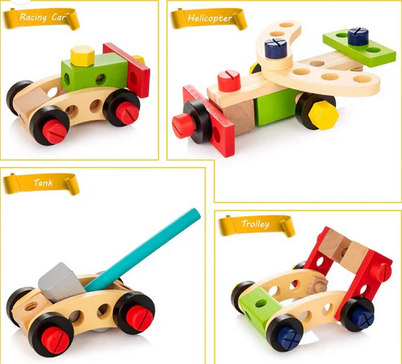The early years of a child's life are filled with rapid growth and development, making it a crucial period for learning through play. Montessori toys have garnered increasing attention for parents seeking the best developmental tools for their toddlers. These toys are designed for entertainment and to enhance cognitive, social, and physical skills. This guide will explore the essence of Montessori toys for 2-year-olds, shedding light on what makes them unique, their benefits, and some practical suggestions for incorporating them into your child’s playtime.
Understanding Montessori Philosophy
To appreciate the value of Montessori toys, it's essential to understand the underlying philosophy. Developed by Dr. Maria Montessori, this educational approach emphasizes child-centered learning, allowing children to explore and discover at their own pace. Montessori toys are specifically designed to promote independence, creativity, and critical thinking. They encourage hands-on interaction, enabling children to learn through experience rather than passive observation.
For instance, a simple wooden stacking toy serves as a fun activity and teaches concepts such as balance and coordination. Children manipulating these toys engages their senses, fostering a deeper understanding of their environment. The emphasis on self-directed activity allows children to make choices and learn from their successes and failures, which is a cornerstone of the Montessori method.
The Importance of Play in Development
Play is not merely a source of joy for toddlers but a vital component of their development. Research has shown that play facilitates learning in various cognitive, social, emotional, and physical domains. Playtime is particularly significant for two-year-olds as they begin to navigate the world around them. During this stage, children develop language skills, enhance motor abilities, and cultivate social interactions.
Montessori toys align perfectly with this developmental phase. They often feature open-ended designs, allowing children to use their imagination and creativity. A wooden block set, for example, can be transformed into a castle, a bridge, or train, depending on the child's vision. This flexibility engages their minds and encourages problem-solving skills as they figure out how to construct their ideas.
Key Features of Montessori Toys
When selecting Montessori toys for your two-year-old, focusing on specific features that enhance their educational value is important. Natural materials like wood are often preferred over plastic, as they are safer and provide a more tactile experience. Additionally, these toys should be designed to inspire exploration and discovery.
For example, toys that encourage sorting and categorization can help develop logical thinking and organizational skills. A set of colorful wooden shapes can be used for sorting by color, size, or shape, allowing children to grasp fundamental concepts playfully. Furthermore, toys that promote fine motor skills, such as threading beads or puzzles, are invaluable at this age, as they help build the dexterity needed for everyday tasks like writing and dressing.
Popular Montessori Toys for Two-Year-Olds
As you embark on selecting the right Montessori toys, consider options catering to your child's interests and developmental needs. Some popular choices include stacking toys, sorting games, and sensory bins.
Stacking toys, like the classic ring stacker, develop hand-eye coordination and introduce concepts of size and order. As toddlers learn to place rings onto a post, they practice their problem-solving skills, assessing which ring fits where. Similarly, sorting games can provide endless learning opportunities. Whether it's sorting animals by habitat or colors, these activities encourage cognitive growth and language development.
Sensory bins, filled with various textures and materials, can also be an excellent addition to your child's play. These bins allow toddlers to explore sensory experiences, from tactile feedback to visual stimulation. For instance, a bin filled with rice, scoops, and small toys can help children improve their fine motor skills while engaging their senses.
Incorporating Montessori Principles at Home
To fully embrace the Montessori approach, consider creating a dedicated play space that encourages independence and exploration. Organize toys to allow your child to access them easily, promoting a sense of ownership and responsibility. This could involve using low shelves displaying toys attractively, inviting your child to choose which ones to play with.
Engaging in your child's playtime without dominating it is also beneficial. Offer guidance when needed, but allow them to lead the activity. This balance fosters confidence and encourages them to express their creativity. Moreover, incorporating everyday tasks into play can enhance their learning experience. For example, cooking together can introduce concepts of measurement and responsibility, aligning perfectly with Montessori principles.
Real-World Impact of Montessori Education
The influence of Montessori education extends beyond childhood. Numerous studies have highlighted the long-term benefits of this approach, with many Montessori alums demonstrating strong academic performance, social skills, and a love for learning. In a world where traditional education systems often emphasize rote memorization, the Montessori method encourages critical thinking and problem-solving, preparing children for the complexities of the future.
One notable example is the success of Montessori schools across the globe. Countries like Italy, where the Montessori method originated, have significantly impacted educational outcomes. Schools implementing this approach often report higher levels of student engagement and creativity, showcasing the effectiveness of learning through play.
As you navigate the world of Montessori toys for your two-year-old, remember that the ultimate goal is to foster a love for learning and exploration. By choosing toys that align with these principles, you are providing your child with engaging play experiences and setting the foundation for a lifetime of curiosity and discovery. Embrace the journey, and enjoy watching your child grow through the magic of play.





Comments